ລາຍງານສະບັບຫຼ້າສຸດ ຂອງສະຫະປະຊາຊາດ ກ່ຽວກັບການຜະລິດຝິ່ນໃນພາກພື້ນເອເຊຍຕາເວັນອອກສຽງໃຕ້ ກ່າວວ່າ ຍັງມີການປູກຝິ່ນຢູ່ຕໍ່ມາຢູ່ໃນຫລາຍໆພື້ນທີ່ສຳຄັນຂອງມຽນມາ ແລະ ສປປ ລາວ ໂດຍໄດ້ມີການປ່ຽນແປງໜ້ອຍຫລາຍ ໃນຜົນຜະລິດ ໃນໄລຍະປີຜ່ານມານີ້. ສິງມີລາຍລະອຽດກ່ຽວກັບເລື້ອງນີ້ ຈາກລາຍງານຂອງ Ron Corben ຜູ້ສື່ຂ່າວວີໂອເອທີ່ບາງກອກ.
ລາຍງານການສຳຫລວດປະຈຳປີ ຂອງຫ້ອງການຢາເສບຕິດແລະອາຊະຍາກຳຂອງສະຫະປະຊາຊາດ ຫລື UNODC ວ່າດ້ວຍການປູກຝິ່ນ ຢູ່ໃນເຂດເອເຊຍຕາເວັນອອກ
ສຽງໃຕ້ ທີ່ເປີດໃຫ້ຮູ້ໃນວັນຈັນ ທີ 8 ທັນວາ ຜ່ານມານີ້ ກ່າວວ່າ ໄດ້ມີການຜະລິດຝິ່ນອອກມາ ໃນຈຳນວນຫຼາຍກວ່າ 760 ໂຕນ ໃນປີແລ້ວນີ້ ສ່ວນໃຫຍ່ແມ່ນຜະລິດຢູ່ໃນມຽນມາ ແລະ ສປປ ລາວ ໃນເນື້ອທີ່ຫຼາຍກວ່າ 63 ພັນເຮັກຕາ.
ຫ້ອງການ UNODC ກວ່າວ່າ ເຖິງແມ່ນຜົນຜະລິດຝິ່ນໃນພາກພື້ນບໍ່ໄດ້ມີການປ່ຽນແປງຫລາຍກໍຕາມ ໃນປີກາຍນີ້ ແຕ່ຄວາມຮຽກຮ້ອງຕ້ອງການຝິ່ນກໍຍັງມີຢູ່ຕໍ່ໄປ ໂດຍສະເພາະ
ຈາກພວກສູບຝິ່ນ ຢູ່ໃນປະເທດຈີນ.
ພວກຊາວໄຮ່ຊາວສວນຊົນເຜົ່າທີ່ທຸກຈົນ ຫລາຍໝື່ນຄົນ ຍັງຄົງກາງຕໍ່ລາຍຮັບຈາກການປູກຝິ່ນ ຍ້ອນພວກເຂົາເຈົ້າອາໄສຢູ່ໃນເຂດພູດອຍ ທີ່ໂດດດ່ຽວຫ່າງໄກ ແລະມີທາງເລືອກໜ້ອຍຫລາຍ ໃນດ້ານວຽກເຮັດງານທຳ.
ເຂດຊາຍແດນຕິດຈອດກັນລະຫວ່າງ ມຽນມາ ລາວ ແລະໄທ ເອີ້ນວ່າ ເຂດ “ສາມຫຼ່ຽມຄຳ” ທີ່ມີຊື່ສຽງນັ້ນ ແມ່ນເປັນຂົງເຂດໃຫຍ່ອັນດັບສອງຂອງໂລກ ໃນການປູກຝິ່ນ ຮອງຈາກອັຟການິສຖານ.
ທ່ານ Jeremy Douglas ຜູ້ຕາງໜ້າ ຫ້ອງການ UNODC ປະຈຳພາກພື້ນເອເຊຍຕາເວັນອອກສຽງໃຕ້ ແລະຍ່ານມະຫາສະມຸດປາຊີຟິກ ກ່າວວ່າ ເຖິງແມ່ນການຜະລິດໄດ້ຢູ່ໃນສະພາບທຸ່ນທ່ຽງ ບໍ່ໄດ້ມີການປ່ຽນແປງຢ່າງໃຫຍ່ຫລວງກໍຕາມ ແຕ່ແນວໂນ້ມໄລຍະຍາວ ໃນຫວ່າງ ບໍ່ເທົ່າໃດປີຜ່ານມານີ້ ໄດ້ສະແດງໃຫ້ເຫັນວ່າ ການຜະລິດຝິ່ນໄດ້ເພີ້ມ ທະວີຂຶ້ນຢ່າງສະໝ່ຳສະເໝີມາ.
ທ່ານ Jeremy ກ່າວວ່າ “ພວກເຮົາລາຍງານເປັນປີທີ 8 ລຽນຕິດແລ້ວ ກ່ຽວກັບ
ການປູກຝິ່ນທີ່ເພີ້ມທະວີຂຶ້ນໃນເຂດສາມຫຼ່ຽມຄຳ. ມັນ ແມ່ນຮວມຈຸດຢູ່ໃນພວກລັດ Shan ແລະການຜະລິດເພີ້ມຂຶ້ນສາມເທົ່າໂຕໃນຊ່ວງເວລາ 8 ປີປາຍຜ່ານມາ. ຢູ່ໃນລາວນັ້ນ ການຜະລິດແມ່ນ ຮວມຈຸດຢູ່ໃນ 3 ແຂວງ ຄື ແຂວງຜົ້ງສາລີ ຫົວພັນ ແລະຊຽງຂວາງ.”
ການຜະລິດຝິ່ນສ່ວນຫຼາຍໃນມຽນມາ ແມ່ນມີຢູ່ໃນພວກລັດ Shan ໃນພາກເໜືອ ໃກ້ກັບຊາຍແດນຕິດກັບຈີນ ບ່ອນທີ່ພວກກຸ່ມຊົນເຜົ່າຕ່າງໆອາໄສລາຍຮັບຈາກການປູກຝິ່ນ ເພື່ອສະໜັບສະໜຸນການກໍ່ການກະບົດຂອງພວກເຂົາເຈົ້າ ມາເປັນເວລາດົນນານນັ້ນ. ບັນດາເຈົ້າໜ້າທີ່ກ່າວວ່າ ທາດເຄມີທີ່ສຳຄັນ ກໍຄືເຄມີຕົ້ນ ທີ່ໃຊ້ຜະລິດຝິ່ນໃຫ້ເປັນຢາເຮໂຣ ອີນນັ້ນ ແມ່ນລັກລອບເຂົ້າມາຈາກຈີນແລະຫວຽດນາມ.
ຫ້ອງການ UNODC ກ່າວວ່າ ປັດຈຸບັນນີ້ ໃນທົ່ວເອເຊຍ ມີພວກຊົມໃຊ້ຝິ່ນຈຳນວນຫຼາຍກວ່າ 3 ລ້ານ 3 ແສນຄົນ ສ່ວນໃຫຍ່ແມ່ນຢູ່ໃນຈີນ ບ່ອນທີ່ພວກສູບຝິ່ນທີ່ມີຊື່ໃນທະບຽນ
ຂອງທາງການ ມີຈຳນວນປະມານ 1 ລ້ານ 9 ແສນຄົນ ຮອງອັນດັບລົງມາແມ່ນຫວຽດນາມ ມຽນມາ ມາເລເຊຍ ອິນໂດເນເຊຍ ແລະໄທ.
ລາຍ ງານສະບັບນີ້ ກ່າວວ່າ ຄວາມຮຽກຮ້ອງຕ້ອງການ ສ່ວນນຶ່ງແມ່ນພົວພັນກັບການຮື້ຟື້ນການປູກຝິ່ນຄືນມາໃນຂົງເຂດເອ ເຊຍຕາເວັນອອກສຽງໃຕ້ ໃນຫວ່າງບໍ່ເທົ່າໃດປີຜ່ານມານີ້. ແຕ່ການເພີ້ມທະວີຂຶ້ນໃນການໃຊ້ຢາບ້າ ເປັນຢາກະຕຸ້ນກຳລັງນັ້ນ ໄດ້ສົ່ງຜົນໃຫ້ການໃຊ້
ຢາເຮໂຣອີນ ລົດລົງ ໃນບັນດາພວກຊົມໃຊ້ຢາເສບຕິດທີ່ລົງທະບຽນທັງໝົດນັ້ນ.
ສອງສ່ວນສາມຂອງຜະລິດຕະພັນຝິ່ນ ໃນເຂດເອເຊຍຕາເວັນອອກສຽງໃຕ້ ແມ່ນອອກໄປຈາກມຽນມາ ແລະລາວ ຊຶ່ງສ່ວນທີ່ເຫຼືອນັ້ນແມ່ນໄປຈາກອັຟການິສຖານ ຊຶ່ງເປັນປະເທດທີ່ຜະລິດເຮໂຣອີນ ລາຍໃຫຍ່ທີ່ສຸດຂອງໂລກ.
ທ່ານ Douglas ຈາກ UNODC ກ່າວວ່າ ເຖິງແມ່ນການຜະລິດຝິ່ນຢູ່ໃນສະພາທຸ່ນທ່ຽງກຕາມ ແຕ່ການຄ້າຂາຍຝິ່ນຂ້າມພາກພື້ນ ມີມູນຄ່າສູງເຖິງ 20 ພັນລ້ານດອນລາ ຊຶ່ງເປັນໄພຂົ່ມຂູ່ຕໍ່ຄວາມໝັ້ນຄົງຂອງ ພາກພື້ນ ໂດຍສະເພາະໃນຂະນະທີ່ພວກ 10 ປະເທດອາຊຽນເລັ່ງລັດ ການໂຮມໂຕເຂົ້າກັນທາງດ້ານເສດຖະກິດໃນຂົງເຂດນັ້ນ.
ຫ້ອງການ UNODC ກ່າວວ່າ ການເຄື່ອນໄຫວໄປສູ່ການໂຮມພາກພື້ນເຂົ້າກັນຫລາຍຂຶ້ນ ການປັບປຸງຖະໜົນຫົນທາງ ແລະໂຄງລ່າງພື້ນຖານໃຫ້ດີຂຶ້ນ ແມ່ນຈະເປັນປະໂຫຍດ ສຳຫລັບພວກກຸ່ມອາຊະຍາກອນຂ້າມຊາດ ຕໍ່ໜ້າການຄວບຄຸມເຂດຊາຍແດນທີ່ອ່ອນແອ ໃນ
ບາງຂົງເຂດ. UNODC ຮຽກຮ້ອງໃຫ້ມີການຈັດຕັ້ງປະຕິບັດໂຄງການ ທາງເລືອກລະຍະຍາວ ສຳຫລັບພັດທະນາ ໃຫ້ພວກປູກຝິ່ນ.
The United Nations' latest report on opium production in Southeast Asia says cultivation remains concentrated in key regions of Myanmar (also known as Burma) and Laos, with little change in output in the past year.
The U.N. Office on Drugs and Crime's annual opium survey for Southeast Asia, released Monday, says over 760 metric tons of opium were produced largely in Myanmar as well as Laos in the past year, over 63,000 hectares.
The UNODC says although the region’s opium output changed little in the past year, there is ongoing demand, especially from opiate users in China.
Tens of thousands of often poor hill-tribe farmers remain dependent on income from opium poppy cultivation, living in isolated regions with few alternatives for work.
The border region of Myanmar, Laos and Thailand, is famously known as the “Golden Triangle,” the world's second largest area for opium production behind Afghanistan.
Jeremy Douglas, UNODC regional representative for Southeast Asia and Pacific, says that although output has stabilized, the long-term trend in recent years has been for a steady increase in production.
"We are reporting the eighth consecutive year for an increase in opium poppy cultivation in the Golden Triangle. This is highly concentrated in the Shan States and three times the production over the period of eight years in the region. In Laos we have three provinces where it is highly concentrated, Phongsali, Houaphan, and Xiangkhoang," says Douglas.
China tops user list
Most production in Myanmar lies in the northern Shan states close to the border with China, where ethnic groups rely on funds from opiates to support a long running insurgency. Authorities say vital chemicals, known as precursors, to break down the opium into heroin, are smuggled in from China and Vietnam.
Across Asia, the UNODC says there are currently over 3.3 million opiate users, largely concentrated in China - where registered users are estimated at 1.9 million, followed by Vietnam, Maynmar, Malaysia, Indonesia and Thailand.
The report says demand is in part linked to the resurgence in opium production in Southeast Asia in recent years. But a surge in use of amphetamine type stimulants has seen heroin use declining as a proportion of all registered drug users.
In Southeast Asia two thirds of opiates are sourced from Myanmar and Laos with the remainder from Afghanistan - the world's largest heroin producer.
UNODC's Douglas says although opiate production has steadied, the trade across the region, is worth up to $20 billion, representing a regional security threat especially as the 10-nation Association of South East Asian Nations (ASEAN) steps up regional economic integration.
"We have to look at this in perspective - it's like an undeclared ‘ASEAN state' that volume of money is just as powerful as some of the other states - in the hands of small groups and they have enormous power and they seem to be able to almost operate unimpeded for many years now."
The UNODC says moves to greater regional integration, improved roads and access infrastructure will likely benefit transnational criminal groups in the face of weak border controls in some regions. The group is calling for long term alternative development programs for opium poppy growers.






